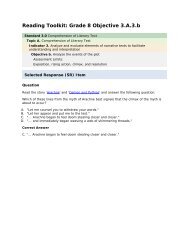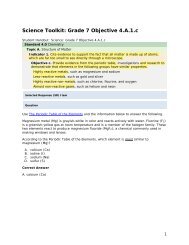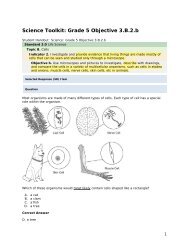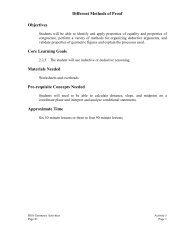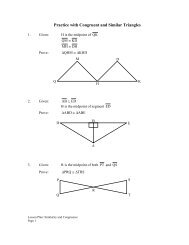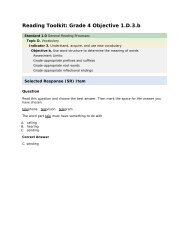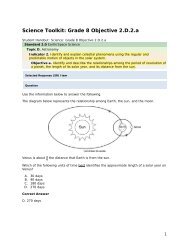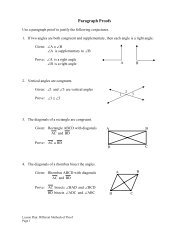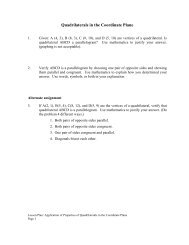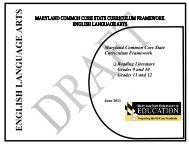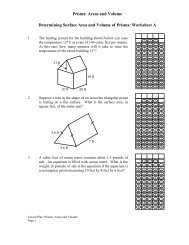Quadrilaterals in the rectangular plane - mdk12
Quadrilaterals in the rectangular plane - mdk12
Quadrilaterals in the rectangular plane - mdk12
Create successful ePaper yourself
Turn your PDF publications into a flip-book with our unique Google optimized e-Paper software.
<strong>Quadrilaterals</strong> <strong>in</strong> <strong>the</strong> Coord<strong>in</strong>ate Plane<br />
Objective<br />
Students will be able to f<strong>in</strong>d <strong>the</strong> coord<strong>in</strong>ates of <strong>the</strong> vertices of special<br />
quadrilaterals placed <strong>in</strong> <strong>the</strong> coord<strong>in</strong>ate <strong>plane</strong>.<br />
Core Learn<strong>in</strong>g Goals<br />
2.1.2 The student will identify and/or verify properties of geometric figures<br />
us<strong>in</strong>g <strong>the</strong> coord<strong>in</strong>ate <strong>plane</strong> and concepts from algebra.<br />
Materials Needed<br />
Worksheets and graph paper – All graphs will be <strong>in</strong> <strong>the</strong> first quadrant. It would<br />
be helpful if <strong>the</strong> teacher had a graph on an overhead projector.<br />
Pre-Requisite Concepts Needed<br />
Students should be able to plot ordered pairs. All quadrilaterals <strong>in</strong> this lesson will<br />
be drawn <strong>in</strong> <strong>the</strong> first quadrant and will be labeled <strong>in</strong> alphabetical sequence,<br />
counter-clockwise. (HSA labels figures <strong>in</strong> alphabetical sequence, clockwise).<br />
Approximate Time<br />
One or two 45-m<strong>in</strong>ute lessons (O<strong>the</strong>r quadrilaterals may be done as you study<br />
<strong>the</strong>m.)<br />
HSA Geometry Activities Activity 8<br />
Page 164 Page 1
<strong>Quadrilaterals</strong> <strong>in</strong> <strong>the</strong> Coord<strong>in</strong>ate Plane<br />
Lesson plan – Squares and Parallelograms<br />
Warm-Up/Open<strong>in</strong>g Activity<br />
Plot segment AB . Given A (2, 0) and B (6, 0), draw a square <strong>in</strong> <strong>the</strong> first quadrant<br />
that has AB as one side.<br />
The teacher should draw AB on <strong>the</strong> overhead sheet. After students have drawn<br />
<strong>the</strong>ir square, have <strong>the</strong>m label <strong>the</strong> vertices so that <strong>the</strong>y have square ABCD. They<br />
should also write <strong>the</strong> pair of coord<strong>in</strong>ates near <strong>the</strong> appropriate vertex. Students can<br />
draw and label as <strong>the</strong> teacher graphs on <strong>the</strong> overhead sheet.<br />
Answers: C (6, 4) and D (2, 4)<br />
Development of Ideas<br />
Key to <strong>the</strong> lesson: Today we are go<strong>in</strong>g to f<strong>in</strong>d <strong>the</strong> coord<strong>in</strong>ates of miss<strong>in</strong>g vertices<br />
of squares and parallelograms. We will apply properties of quadrilaterals and<br />
what we know about graph<strong>in</strong>g to f<strong>in</strong>d <strong>the</strong>se vertices.<br />
Let’s try ano<strong>the</strong>r square that is not as easy. Plot A (3, 5) and B (9, 5).<br />
Now try to f<strong>in</strong>d <strong>the</strong> coord<strong>in</strong>ates for C and D so that a square is formed.<br />
Answers: C (9, 11) and D (3, 11)<br />
After students have f<strong>in</strong>ished, discuss <strong>the</strong> relationships between <strong>the</strong> sides of <strong>the</strong><br />
square. The length of AB is 6 so <strong>the</strong>y know that <strong>the</strong> length of each side will be 6.<br />
What is special about <strong>the</strong> coord<strong>in</strong>ates of C? or what pattern do you see that can<br />
help you f<strong>in</strong>d C?<br />
Assist students to see that <strong>the</strong> x value will be <strong>the</strong> same as <strong>the</strong> x value for B. The y<br />
value of C is computed by add<strong>in</strong>g <strong>the</strong> length 6 to <strong>the</strong> y value of B.<br />
What patterns can we see for po<strong>in</strong>t D?<br />
Show: D (3, 5 + 6) or (3, 11) C (9, 5 + 6) or (9, 11)<br />
A (3, 5) B (9, 5)<br />
How do we know we have a square? Use ma<strong>the</strong>matics to justify your answer.<br />
Students should be able to tell you that you need to show 4 congruent sides as<br />
well as at least one right angle. You can <strong>the</strong>n divide up <strong>the</strong> labor of us<strong>in</strong>g <strong>the</strong><br />
distance formula and <strong>the</strong> slope formula. Side length = 6 and slopes of 2<br />
HSA Geometry Activities Activity 8<br />
Page 165 Page 2
<strong>Quadrilaterals</strong> <strong>in</strong> <strong>the</strong> Coord<strong>in</strong>ate Plane<br />
Development of Ideas (Cont<strong>in</strong>ued)<br />
consecutive sides: 0 and undef<strong>in</strong>ed. Then have students write a justification, i.e.,<br />
Because ABCD has 4 congruent sides and a right angle, we know from <strong>the</strong><br />
<strong>the</strong>orems of parallelograms and by def<strong>in</strong>ition of a square that ABCD is a square.<br />
Let’s f<strong>in</strong>d <strong>the</strong> coord<strong>in</strong>ates of <strong>the</strong> miss<strong>in</strong>g vertices when we are given variable<br />
coord<strong>in</strong>ates. Given <strong>the</strong> coord<strong>in</strong>ates A (m, n) and B (g, n), we can roughly plot<br />
<strong>the</strong>se po<strong>in</strong>ts. It is helpful to students to draw and label <strong>the</strong> axes with <strong>the</strong> variables<br />
as shown below:<br />
n<br />
A<br />
B<br />
m<br />
g<br />
What is <strong>the</strong> length of AB ? (g - m)<br />
What are <strong>the</strong> coord<strong>in</strong>ates of C and D? Give students time to work on this.<br />
Work<strong>in</strong>g <strong>in</strong> pairs might also be helpful.<br />
Solution: C (g, n + (g - m)) and D (m, n + (g - m)).<br />
Worksheet: F<strong>in</strong>d<strong>in</strong>g Miss<strong>in</strong>g Vertices of Squares and Parallelograms<br />
Answers: 1. C (12,11) Students could apply any of <strong>the</strong> <strong>the</strong>orems that are<br />
used to prove a quadrilateral is a parallelogram. Such as:<br />
<strong>the</strong> slope of AB and CD is 0 so AB and CD are parallel<br />
s<strong>in</strong>ce <strong>the</strong>y have <strong>the</strong> same slope. Their lengths are congruent<br />
(7 by <strong>the</strong> distance formula). So ABCD is a parallelogram<br />
by <strong>the</strong> <strong>the</strong>orem: a quadrilateral is a parallelogram if one<br />
pair of opposite sides is parallel and congruent.<br />
2. H (m + r – p, s)<br />
HSA Geometry Activities Activity 8<br />
Page 166 Page 3
<strong>Quadrilaterals</strong> <strong>in</strong> <strong>the</strong> Coord<strong>in</strong>ate Plane<br />
Development of Ideas (Cont<strong>in</strong>ued)<br />
Assignment<br />
Answers: 1. B (9, 1) and C (9, 8)<br />
2. C (5, 8) and D (1, 5) ABCD is a square because it is<br />
a parallelogram with 4 congruent sides (5, us<strong>in</strong>g <strong>the</strong><br />
distance formula) and angle A is a right angle (slope<br />
of AB is 3/4 and <strong>the</strong> slope of AC is 4/-3).<br />
3. B (e + h - f, f) and C (e + h - f, h)<br />
HSA Geometry Activities Activity 8<br />
Page 167 Page 4
<strong>Quadrilaterals</strong> <strong>in</strong> <strong>the</strong> Coord<strong>in</strong>ate Plane<br />
F<strong>in</strong>d<strong>in</strong>g Miss<strong>in</strong>g Vertices of Squares and Parallelograms<br />
1. ABCD is a parallelogram. Given A (3, 4) B (10, 4) D (5, 11), plot and locate <strong>the</strong><br />
po<strong>in</strong>t C. Label <strong>the</strong> parallelogram. What are <strong>the</strong> coord<strong>in</strong>ates of C? Use<br />
ma<strong>the</strong>matics to justify that your coord<strong>in</strong>ates of C make ABCD a parallelogram.<br />
2. EFGH is a parallelogram. Given E (m, n), F (p, n), and G (r, s). Locate H <strong>in</strong> <strong>the</strong><br />
draw<strong>in</strong>g. What are <strong>the</strong> coord<strong>in</strong>ates of H?<br />
s<br />
G<br />
n<br />
E<br />
F<br />
m<br />
p<br />
r<br />
Assignment<br />
For square ABCD <strong>in</strong> <strong>the</strong> first quadrant, draw <strong>the</strong> square and f<strong>in</strong>d <strong>the</strong> miss<strong>in</strong>g vertices.<br />
What are <strong>the</strong> coord<strong>in</strong>ates of <strong>the</strong>se vertices?<br />
1. A (2, 1) B( ) C( ) D (2, 8)<br />
2. A (4, 1) B (8, 4) C( ) D ( )<br />
Use ma<strong>the</strong>matics to justify that ABCD is a square.<br />
3. A (e, f) B( ) C( ) D (e, h)<br />
HSA Geometry Activities Activity 8<br />
Page 168 Page 5
<strong>Quadrilaterals</strong> <strong>in</strong> <strong>the</strong> Coord<strong>in</strong>ate Plane<br />
Lesson Plan – Rectangles and Trapezoids<br />
Warm-Up/Open<strong>in</strong>g Activity<br />
Plot and f<strong>in</strong>d <strong>the</strong> coord<strong>in</strong>ates of <strong>the</strong> miss<strong>in</strong>g vertices of Rectangle ABCD.<br />
A (1, 7), B( ), C (3, 10), D( )<br />
The teacher should have plotted A and C on <strong>the</strong> overhead. After students have<br />
time to complete this activity, have a student expla<strong>in</strong> how <strong>the</strong> vertices were<br />
determ<strong>in</strong>ed.<br />
Answer: B (3, 7) and D (1, 10)<br />
Development of Ideas<br />
Key to <strong>the</strong> lesson: Today we will cont<strong>in</strong>ue our study of f<strong>in</strong>d<strong>in</strong>g <strong>the</strong> coord<strong>in</strong>ates of<br />
miss<strong>in</strong>g vertices of quadrilaterals. We will f<strong>in</strong>d <strong>the</strong> miss<strong>in</strong>g vertices of rectangles<br />
and trapezoids.<br />
Worksheet: F<strong>in</strong>d<strong>in</strong>g Miss<strong>in</strong>g Vertices of Rectangles and Trapezoids<br />
Assignment<br />
Answers: 1. C (n, j)<br />
2. C (6, 5) Students should use <strong>the</strong> slope formula to<br />
show AB is parallel to CD (<strong>the</strong> slope of each<br />
segment is 0) and <strong>the</strong> distance formula to show AD<br />
is congruent to BC , length is 13 .) ABCD is an<br />
isosceles trapezoid by def<strong>in</strong>ition: a trapezoid is<br />
isosceles if <strong>the</strong> legs are congruent.<br />
3. D (e + h - f, g)<br />
Answers: 1. C (10, 8) Students can use <strong>the</strong> slope formula to<br />
show: opposite sides are parallel (slopes are: 0 and<br />
undef<strong>in</strong>ed), <strong>the</strong>n pairs of consecutive sides are<br />
perpendicular are perpendicular. ABCD is a<br />
parallelogram with right angles so ABCD is a<br />
rectangle by def<strong>in</strong>ition.<br />
2. C (m, v)<br />
HSA Geometry Activities Activity 8<br />
Page 169 Page 6
<strong>Quadrilaterals</strong> <strong>in</strong> <strong>the</strong> Coord<strong>in</strong>ate Plane<br />
Development of Ideas (Cont<strong>in</strong>ued)<br />
Closure<br />
Answers to <strong>the</strong> Assignment (Cont<strong>in</strong>ued)<br />
3. (8, 10) The results of f<strong>in</strong>d<strong>in</strong>g <strong>the</strong> slopes of <strong>the</strong> four<br />
sides: AB and CD are parallel s<strong>in</strong>ce m = 0 for<br />
each. The slope of AD is 2 and <strong>the</strong> slope of BC is<br />
-2. Therefore AD and BC must be <strong>the</strong> non-parallel<br />
sides: legs. Us<strong>in</strong>g <strong>the</strong> distance formula we f<strong>in</strong>d <strong>the</strong><br />
length of each leg is <strong>the</strong> same: 20 . By def<strong>in</strong>ition<br />
ABCD is an isosceles trapezoid because it is a<br />
quadrilateral with exactly one pair of parallel sides<br />
and <strong>the</strong> legs are congruent.<br />
4. C (h - (n - w), q)<br />
On a scale of 1 to 5 (5 mean<strong>in</strong>g you could teach this to someone, 4 you feel like<br />
an expert but not quite ready to teach it. 3: you can do this with a little help. 2:<br />
you can get it started but still need lots of help and 1: you don’t know what you<br />
are do<strong>in</strong>g!) please rate your knowledge of plott<strong>in</strong>g and f<strong>in</strong>d<strong>in</strong>g coord<strong>in</strong>ates of<br />
quadrilaterals. (Check for understand<strong>in</strong>g).<br />
HSA Geometry Activities Activity 8<br />
Page 170 Page 7
<strong>Quadrilaterals</strong> <strong>in</strong> <strong>the</strong> Coord<strong>in</strong>ate Plane<br />
F<strong>in</strong>d<strong>in</strong>g Miss<strong>in</strong>g Vertices of Rectangles and Trapezoids<br />
1. F<strong>in</strong>d <strong>the</strong> coord<strong>in</strong>ates of <strong>the</strong> miss<strong>in</strong>g vertex of rectangle ABCD.<br />
Given: A (e, f), B (n, f), D (e, j)<br />
j<br />
D<br />
f<br />
A<br />
B<br />
e<br />
n<br />
2. ABCD is an isosceles trapezoid <strong>in</strong> <strong>the</strong> first quadrant. Draw <strong>the</strong> trapezoid. What<br />
are <strong>the</strong> coord<strong>in</strong>ates of C. Given: A (1, 2), B (8, 2), D (3, 5). Use ma<strong>the</strong>matics to<br />
justify your answer.<br />
3. Locate po<strong>in</strong>t D of an isosceles trapezoid <strong>in</strong> <strong>the</strong> first quadrant.<br />
Given: A (e, d), B (h, d), C (f, g). What are <strong>the</strong> coord<strong>in</strong>ates of D?<br />
g<br />
C<br />
d<br />
A<br />
B<br />
e<br />
f<br />
h<br />
HSA Geometry Activities Activity 8<br />
Page 171 Page 8
<strong>Quadrilaterals</strong> <strong>in</strong> <strong>the</strong> Coord<strong>in</strong>ate Plane<br />
F<strong>in</strong>d<strong>in</strong>g Miss<strong>in</strong>g Vertices of Rectangles and Trapezoids (Cont<strong>in</strong>ued)<br />
Assignment<br />
F<strong>in</strong>d <strong>the</strong> coord<strong>in</strong>ates of <strong>the</strong> miss<strong>in</strong>g vertices of <strong>the</strong> rectangles:<br />
1. A (2, 3), B (10, 3), C ( ), and D (2, 8).<br />
Use ma<strong>the</strong>matics to justify that ABCD is a rectangle.<br />
2. A (p, q), B (m, q), C ( ),and D (p, v).<br />
F<strong>in</strong>d <strong>the</strong> coord<strong>in</strong>ates of <strong>the</strong> miss<strong>in</strong>g vertices of <strong>the</strong> follow<strong>in</strong>g isosceles trapezoids<br />
3. A (3, 6), B (10, 6), C( ), and D (5, 10).<br />
Use ma<strong>the</strong>matics to justify that ABCD is an isosceles trapezoid.<br />
4. A (w, t), B (h, t), C ( ), and D (n, q)<br />
HSA Geometry Activities Activity 8<br />
Page 172 Page 9




